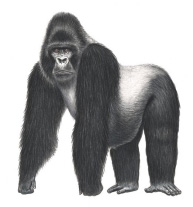Eastern GorillasGorilla beringei Matschie, 1903 Democratic Republic of Congo, Rwanda, Uganda Caught in the crossfire of human civil war, an untold number of eastern gorillas have been killed in the relentless ebb and flow of violence in the Congo. |
 |
|
The eastern gorilla is the world's largest living primate, one of the best studied, and unfortunately, one of the most threatened. Approximately 480 mountain gorillas survive in the Virunga Volcanoes (425 km2, 700-4,000 m a.s.l.) where they are protected in three national parks #&151; Virunga National Park (Democratic Republic of Congo), Volcanoes National Park (Rwanda), and Mgahinga Gorilla National Park (Uganda). Another 300 or so gorillas live in the Bwindi Impenetrable National Park, Uganda (320 km2, 1,500-2,300 m a.s.l.). The Virunga Volcanoes and Bwindi Impenetrable Forest are surrounded by dense human settlements and agricultural lands on some of the most fertile volcanic soils in the world. Nonetheless, these four national parks are among the best-protected in Africa. As such, both populations have increased in recent years. The vast majority of eastern gorillas, however, live over an area of roughly 15,000 km2 in eastern Democratic Republic of Congo (DRC). These belong to a distinct subspecies; Grauer's gorilla, G. beringei graueri Matschie, 1914. The number of eastern gorillas in DRC was estimated at 8,660-25,500 individuals (in at least 11 populations) in 1995, with about two-thirds living in the Kahuzi-Biega and Maiko National Parks. There has been considerable insecurity and civil strife in eastern DRC in recent years, with the result that gorillas in this region have likely declined in number-perhaps dramatically. The entire region over which eastern gorillas live has experienced devastating human conflicts in recent decades, with an estimated human mortality of almost 5 million people. Despite these problems, the International Gorilla Conservation Program (IGCP)-a coalition of the African Wildlife Foundation (AWF), Fauna and Flora International (FFI) and the World Wide Fund for Nature (WWF)-has worked together with the Dian Fossey Gorilla Fund International, The Wildlife Conservation Society, and many other organizations to maintain long-term support of the eastern gorilla. Coupled with sustained anti-poaching efforts against relentless pressure, the IGCP has worked with the national park authorities in the three habitat countries (Uganda Wildlife Authority, Office Rwandais de Tourisme et des Parcs Nationaux, and the Institut Congolais pour la Conservation de la Nature), together with local people, to successfully establish this magnificent primate as one of the premier tropical forest tourism attractions on the African continent. Annette Lanjouw, Thomas M. Butynski & William R. Konstant |
|
References Butynski, T. M. 2001. Africa's great apes. In: Great Apes and Humans: The Ethics of Co-existence, B. B. Beck, T. S. Stoinski, M. Hutchins, T. L. Maple, B. Norton, A. Rowan, E. F. Stevens and A. Arluke (eds.), pp.3-56. Smithsonian Institution Press, Washington, DC. Suggested citation: Lanjouw, A., Butynski, T. M. and Konstant, W. R. 2005. The Eastern Gorillas, Gorilla beringei Matschie, 1903. In: Primates in Peril: The World's 25 Most Endangered Primates 2004-2006, R. A. Mittermeier, C. Valladares-Pádua, A. B. Rylands, A. A. Eudey, T. M. Butynski, J. U. Ganzhorn, R. Kormos, J. M. Aguiar and S. Walker (eds.), p.20. Report to IUCN/SSC Primate Specialist Group (PSG), International Primatological Society (IPS) and Conservation International (CI), Washington, DC |


